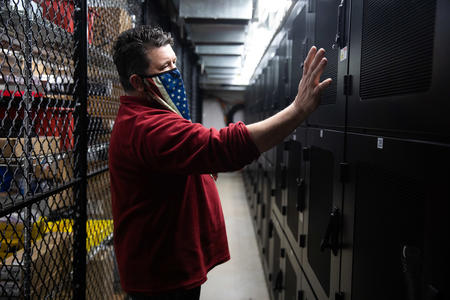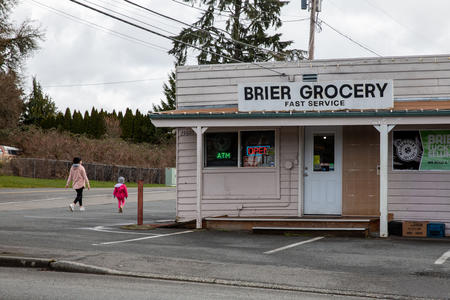Nicky — who asked to be identified by only her first name because she fled domestic violence — eventually found a new job. But she said she burned through her savings in the process and is still digging out of rental debt, which she has whittled down from four to two months.
Back in December, she applied for federal rent assistance through Community Action Council of Lewis, Mason, and Thurston counties, a local nonprofit contracted to manage rental assistance for Thurston County. Nicky said she was told everything was in order, and a check should be forthcoming within a few weeks.
But the check never came. She started calling and emailing an organization that helped her file the application, which directed her to the county, which told her a new company would now process her application and she may have to resubmit her information.
“It’s like I’m getting a different [story] every time I talk to somebody,” Nicky said.
Then her landlord sent her a news article. “I hope this isn’t the organization that’s supposed to be helping you,” she recalled him saying.
In a closed-door meeting on Feb. 23, the Thurston County Board of Commissioners had decided to immediately terminate its contract with the Community Action Council. In a press release, the county cited $86,000 in suspicious payments identified during a routine review of the program. The Community Action Council has disputed the findings and maintains there was no fraud.
Internal documents obtained by Crosscut via public records request show communications breaking down between both parties in the wake of the program audit. County officials contend The Community Action Council resisted efforts to address potentially fraudulent payments, while the action council said it needed clarifications before implementing any recommended changes, but the county instead shut down the program based on unproved allegations.
"[As] CACLMT has made no indication to the County that it is willing to reconsider its response, and has filed a formal complaint against county staff, including the county auditor and county manager, the County is compelled to move forward with finding an alternate rent assistance provider," a Feb. 28 county report stated.
The report also indicated the county felt the audit findings were fixable, but decided to terminate the contract because it felt the action council’s response was unacceptable.
“Had CACLMT responded indicating that it was open to working with the County to address recommendations,” the report stated, “ … the County is confident an acceptable resolution could have been found.”
The decision to suddenly suspend the county’s rent assistance without a replacement provider has left hundreds of tenants like Nicky hanging in uncertainty for two months.
“I’m not evicted, and I don’t have a pay-or-vacate [notice], and I’m so lucky for that,” she said. “But not everyone is that lucky.”
Mattie Leighton, case support staff member, and Isaid Orozco Lugo, lead eviction resolution specialist, pose for a portrait at the Dispute Resolution Center of Thurston County in Olympia on April 21, 2022. The staff at the center work to broker deals between landlords and tenants facing eviction. (David Ryder for Crosscut)
Local eviction notices increasing
Nicky is one of more than 1,000 tenants in Thurston County who applied or were approved for help before the program abruptly shut down.
Jody Suhrbier sees many of these tenants in her role as executive director of the Dispute Resolution Center of Thurston County, where mediators have been swamped with “skyrocketing” caseloads. Under state legislation passed in 2021, landlords must notify tenants and participate in these “eviction resolution” programs offered by a local dispute resolution center before filing for eviction in court.
“For some of these partnerships between landlords and tenants,” Suhrbier said, “the rental assistance is a huge, huge piece of what’s going to make this OK.”
The dispute resolution center saw a nearly 30% increase in cases in March, according to Suhrbier, with more than 500 people seeking mediation over unpaid rent.
This story is a part of Crosscut’s WA Recovery Watch, an investigative project tracking federal dollars in Washington state.
Unlike with many of the tenants they assist, Nicky has a landlord who has been patient while she looked for and eventually found a new job in Tacoma, which took longer than she expected. He has not issued a 14-day pay-or-vacate notice, the first step in a legal process that can lead to eviction.
“We see a lot of notices going out the day folks are late of even just the current month’s rent,” Suhrbier said. “It’s jarring to receive a notice like this, especially if you’re someone who has paid consistently.”
After more than eight weeks, Thurston County expects its new contractor to start accepting new applications for rent assistance next week. Officials formally apologized for the interruption in an update posted to the county’s website on April 14.
“Thurston County acknowledges that the sudden suspension of the rent assistance program caused a great deal of stress, anxiety and upset in the community,” the statement read. “We’re deeply sorry that this transition had these impacts.”
An impasse over audit findings
Emails show the county’s internal auditor shared the suspicious payments with Community Action Council leadership in a report dated Jan. 24. It suggested recommendations for improvement and flagged six alarming payments out of a sample of 14. The report was overall positive and judged the Community Action Council to be doing a good job.
In a response on Feb. 14, the action council’s chief executive officer, Kirsten York, contended that the recommendations contradicted previous instructions from the county. She asked for any protocol changes to be put into a formal contract amendment.
“Some details of these recommendations do not align with our understanding of reducing barriers for clients accessing these services,” York wrote, adding that she worried the additional scrutiny could lead to “subjective decision-making on behalf of staff or biases toward low-income clients.”
In an interview, York couldn’t point to any specific county recommendations that would have added barriers for clients or changed eligibility, but said her agency was “unsure” about the changes and sought clarification “from the decision-makers about what that definition of fraudulent payments and eligibility would look like.”
Nine days after York’s response, Thurston County Manager Ramiro Chavez held the closed-door meeting with two of the county’s commissioners (the third was in the hospital at the time) during which they decided to terminate the contract.
Chavez declined to answer questions about the rationale behind terminating the contract, saying the decision was made in an executive session. He instead called attention to the now-public communications between the county and the action council, saying he believed the board’s reasoning “speaks for itself.”
The Thurston County Auditor’s Office regularly monitors contracts like these, especially ones with large amounts of federal money, according to Chief Deputy Auditor Diana Benson. What usually happens when they find something concerning is they ask for more information from the contractor to assess the extent of the problem and suggest tighter controls, which is usually well-received.
Even more serious cases that rise to the level of reporting to the state auditor’s office, she said, are usually resolved in a “fairly uneventful, undramatic fashion.” Benson said the office's staff were surprised by the action council’s “lack of response” to what the auditor's office viewed as a relatively simple, routine process.
“It’s usually pretty unexciting work,” Benson said. “I don't want to overuse the word unprecedented, because we’ve heard that a lot lately. But at least in my humble opinion, this situation is unprecedented in the communication and cooperation category.”
York responded that the action council had a responsibility to be careful about making changes.
“Our agency simply asked for clarification to be transparent and clear in writing in our contract to ensure we were compliant. From our perspective the conversation between a provider and a funder is – there’s opportunity for clarification requests,” she told Crosscut. “So it’s disappointing that that’s the narrative the Thurston County Auditor’s Office is portraying.”
The suspicious findings in the audit report have not been confirmed as fraud. Benson said they expect to do more digging, but don’t know how long that will take.
Fraud is rare, concern is widespread
It’s unclear how much rent assistance fraud is going on statewide. The state Department of Commerce, which oversees the program, doesn’t formally track fraud, and the Office of the Washington State Auditor said it is not aware of any other reports of fraud in federal rent assistance programs, aside from those self-reported by Thurston and, more recently, King County.
In a few other counties, criminal prosecutions involving relatively small amounts of rent assistance money have made the papers.
In January, a 71-year-old man was held in Benton County jail on theft charges for collecting nearly $79,000 from the county’s relief program by falsely claiming to be a property manager. And in Asotin County, two men were charged with felony theft last month over allegedly submitting false information to obtain $12,000 in rent relief.
Any rent assistance fraud that counties uncover in excess of $100,000 is meant to be reported to the U.S. Treasury. A spokesperson referred questions about national fraud trends to the agency’s Office of the Inspector General, which declined to provide any information.
Some states have self-reported fraud data. California identified about 1,800 fraudulent rent assistance applications out of nearly 500,000 — or 0.0036% — the Associated Press reported last November. State officials in New York and Utah also reported fraud rates of less than 1%.
However, fear of fraud — and, by extension, of a federal audit — is widespread amongst local governments, according to researchers studying federal rent assistance programs.
“There’s this trade-off where if you target [fraud] too heavily, that comes with administrative burdens that fall on the intended recipients,” said Claudia Aiken, a researcher at the University of Pennsylvania.
In a study that surveyed more than 200 programs nationwide, Aiken and researchers from New York University and the National Low-Income Housing Coalition found that local administrators sometimes added documentation requirements that bogged down the process and excluded eligible tenants in need. They also tended to be less trustful of tenants than landlords.
“I think on some level,” she said, “we may have to be willing to accept some small amount of fraud in order to provide assistance quickly to those most in need.”
A variety of barriers
King County announced on April 4 that an internal audit conducted beginning in mid-February found 130 payments that raised red flags, accounting for less than 1% of total expenditures. King County has given out more than $318 million in rent assistance, so 1% would be about $3.18 million. Now the county is seeking a third-party audit of all payments and say they intend to recoup any funds improperly spent.
The difference between the counties' handling of suspicious payments demonstrates how the amount of fraud authorities may tolerate can vary by region, by level of government, and even by program.
Thurston County Manager Chavez said no amount of fraud is acceptable and pushed back against the idea of a threshold or any comparison to King County’s handling of potential fraud.
“We have taken those actions even when we have a small amount of evidence,” Chavez said. “A single dollar is a single dollar, and that is a responsibility.”
Rent assistance programs got off to a slow start in many Washington counties in 2021. Some of the hurdles were logistical — King County contracted with a company called GrantCare to build a new data tracking system that took until September to get online. Others may have distributed relief conservatively, despite high levels of demand, in part because of fraud concerns.
“One of the conversations we would have with a county, we’d say, ‘Hey you’re not spending very quickly,’ and they would bring up, ‘Well we’re worried about misuse of funds,’ ” said Ted Kelleher, managing director of the housing assistance unit at the state Department of Commerce. “So that was a constant conversation.”
As local governments across the country struggled to write checks, the U.S. Treasury last August revised its guidance, pushing grantees to allow tenants to self-report eligibility rather than submitting paperwork. That helped speed things up in places like Washington, but other states clung to high-barrier policies. By the end of January, 15 states had spent less than 30% of their initial tranche of funds. In March, 10 states were forced to return millions in unspent funds to the Treasury.
Thurston County received nearly $30 million from the federal government throughout 2021 for rent assistance, a significant amount for a county with an operating budget of $334 million.
Federal and state data show the county’s rent assistance payments began in April 2021 at less than $500,000 a month. Payments through the Community Action Council started to increase in June, ramping up to about $6.6 million in September. But they dropped soon after to less than $1 million a month, with the exception of a bump in January 2022.
All told, the action council distributed rent assistance to more than 3,900 households between April 2021 and February 2022.
Tenants still waiting
After months of waiting, help may be on the way. Nicky said she called the new rental assistance contractor, Seattle-based LiveStories, last week and finally got through to someone who confirmed it had received her application. The person didn’t give a date, but confirmed with her landlord that she was eligible.
Her takeaway was that it sounded like “a when, not an if.”
But not everyone can afford to wait so long. Nicky said she was nearly ready to give up on the process, and had begun looking for extra work and selling her clothes to pay off the debt.
Suhrbier, at the dispute resolution center, described rent relief as a “major lifeline” for tenants like Nicky. “So the disruption is just unfortunately another stressor in an already really stressed system,” she added.
Washington lawmakers increased document recording fees last year to create a permanent state-level rent assistance program amid growing evidence that evictions — often triggered by less than one month’s rent overdue — contribute to regional homelessness.
Nicky said she has experienced homelessness before, and has worked hard to make a better situation for her young son. She said the action council may have screwed up, but added that the county also should have had an alternative provider in place before pulling the plug.
“Because of their lack of judgment and because they took their time and handled this so poorly,” she said, “they are really putting a lot of people at risk and creating a lot of housing insecurity unnecessarily.”








